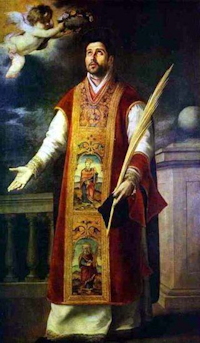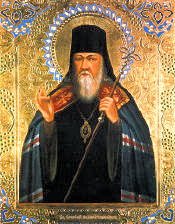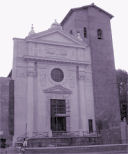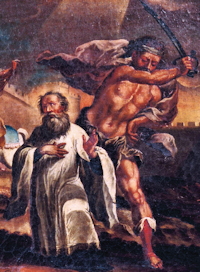Lent: March 11th
Monday of the Fourth Week of Lent
Other Commemorations: St. Eulogius, Priest and Martyr (RM); St. Sophronius, Bishop (RM)
» Enjoy our Liturgical Seasons series of e-books!
During the next two weeks the Gospel for each Lenten weekday Mass is from St. John. We shall read, day after day, about the growing hostility against Jesus that climaxed in the horror of Good Friday. The tragedy begins today on a happy note—a continuation of yesterday’s Laetare Sunday spirit. —The Vatican II Weekday Missal
The Roman Martyrology today commemorates the martyred priest, St. Eulogius of Cordoba, Spain (d. 859), who was slain by the Moors. A noted scholar of Scripture, Eulogius was arrested in 850 after writing Exhortation of Martyrdom for two young virgin martyrs, Flora and Mary, who were beheaded after refusing to abjure the faith. Released after a time Eulogius was named archbishop of Cordoba or Toledo. Before he could be consecrated, he aided Leocritia, a young Moorish woman who had converted to Christianity. They were caught and beheaded. Eulogius also wrote The Memorial of the Saints and an Apologia.
St. Sophronius (d. 638) is also included in today's Roman Martyrology. He was a simple monk who pursued a life of prayer and sacrifice first in the desert of Egypt, then near the Jordan River, then finally in the Holy City of Jerusalem. He was ultimately chosen to be bishop and Patriarch of Jerusalem in the early 7th century. He valiantly defended the true and full humanity of Christ in the face of the heresy of Monothelitism, which denied that Jesus had a human as well as a divine will. The year before his death in 638, he witnessed the capture of Jerusalem by the Muslims under the Caliph Omar. Several of his sermons and poems have survived until this day. St. Sophronius is one of the Fathers of the Church.
Meditation on the Liturgy
In the first reading of today's Mass, the prophet Isaiah offers a vision of the Messianic Age, which Jesus proclaimed to have begun in himself and by his ministry. The Easter "surprise" toward which the Forty Days leads pilgrims is that this Messianic Age, the Kingdom or Reign of God, will break into history in a wholly unexpected, even counterintuitive, way: it will be established through a new Passover marked by the Cross, the Resurrection, the Ascension, and the sending of the Holy Spirit at Pentecost. And as a result, a new People of God that embraces both Jews and Gentiles will be born into history. For now, Jesus gives another sign of the inbreaking of the Kingdom in today's gospel reading, the cure of the royal official's son. The official, like all disciples, must abandon himself to the divine will: As Father Benedict Bro, a Dominican, put it, "God is God only when I accept the fact that I need him."
Another Dominican, Bede Jarrett, developed the same theme in a way that sheds more light on the imitation of Christ, the obedient Son, to which this phase of the Forty Days calls us:
This life of ours…is a gift from God. It is not of our choosing. It comes to us by his choice. Since it is of his choosing, it is of his designing. We neither made ourselves nor can we manage ourselves as we like, nor manage the life that comes to us. For that reason we can take a most helpful view of life….[For] the thought that it is his gift and after his design gives us courage. If to this remembrance of God's creatorship we add the mystery of the Resurrection, we shall take even larger draughts of hope; for not only life but life's triumph lies entirely in the hands of God
—George Weigel, Roman Pilgrimage
St. Eulogius
 St. Eulogius was of a senatorian family of Cordova, at that time the capital of the Moors in Spain. Our Saint was educated among the clergy of the Church of St. Zoilus, a martyr who suffered with nineteen others under Diocletian. Here he distinguished himself, by his virtue and learning, and, being made priest, was placed at the head of the chief ecclesiastical school at Cordova. He joined assiduous watching, fasting, and prayer to his studies, and his humility, mildness, and charity gained him the affection and respect of every one.
St. Eulogius was of a senatorian family of Cordova, at that time the capital of the Moors in Spain. Our Saint was educated among the clergy of the Church of St. Zoilus, a martyr who suffered with nineteen others under Diocletian. Here he distinguished himself, by his virtue and learning, and, being made priest, was placed at the head of the chief ecclesiastical school at Cordova. He joined assiduous watching, fasting, and prayer to his studies, and his humility, mildness, and charity gained him the affection and respect of every one.
During the persecution raised against the Christians in the year 850, St. Eulogius was thrown into prison and there wrote his Exhortation to Martyrdom, addressed to the virgins Flora and Mary, who were beheaded the 24th of November, 851. Six days after their death Eulogius was set at liberty. In the year 852 several others suffered the like martyrdom. St. Eulogius encouraged all these martyrs to their triumphs, and was the support of that distressed flock.
The Archbishop of Toledo dying in 858. St. Eulogius was elected to succeed him; but there was some obstacle that hindered him from being consecrated, though he did not outlive his election two months.
A virgin, by name Leocritia, of a noble family among the Moors, had been instructed from her infancy in the Christian religion by one of her relatives, and privately baptized. Her father and mother used her very ill, and scourged her day and night to compel her to renounce the Faith. Having made her condition known to St. Eulogius and his sister Anulona, intimating that she desired to go where she might freely exercise her religion, they secretly procured her the means of getting away, and concealed her for some time among faithful friends.
But the matter was at length discovered, and they were all brought before the cadi, who threatened to have Eulogius scourged to death. The Saint told him that his torments would be of no avail, for he would never change his religion. Whereupon the cadi gave orders that he should be carried to the palace and be presented before the king's council. Eulogius began boldly to propose the truths of the Gospel to them. But, to prevent their hearing him, the council condemned him immediately to lose his head. As they were leading him to execution, one of the guards gave him a blow on the face, for having spoken against Mahomet; he turned the other cheek, and patiently received a second.
He received the stroke of death with great cheerfulness, on the 11th of March, 859. St. Leocritia was beheaded four days after him, and her body thrown into the river Guadalquivir, but taken out by the Christians.
—Excerpted from Lives of the Saints, by Alban Butler, Benziger Bros. ed. [1894]
Patronage: carpenters; coppersmiths
Highlights and Things to Do:
- Read more about St. Eulogius of Cordoba:
- Read He Chose to Die for Christ in Crisis Magazine.
- His relics are enshrined in the Oviedo Cathedral in Spain.
St. Sophronius
 Patriarch St. Sophronius of Jerusalem was called the Sophist because of his knowledge of Greek. He was an ardent opponent of monothelitism. Many of his writings, including the Florilegium and the Life of St. John the Almsgiver, are no longer extant. He wrote an encomium on John of Cyrus and composed 23 anacreontic odes on the feasts of the church. His Christmas homily of 634 suggests that the Saracens held Bethlehem at that time. (Historians had dated the event later). The Orthodox remember St. Sophronius chiefly as the author of the life of St. Mary of Egypt. Sophronius was born in Damascus around 560. He and his friend John Moschus became ascetics together while they were in their late teens or early twenties. Some say they lived near the Jordan; some say they lived in Egypt. In 605, Sophronius fled to Alexandria in the wake of Persian invaders, and when the Persians invaded Alexandria in 616, he fled to Rome. In 619, he returned to Palestine and lived in the Theodosius monastery in Jerusalem. When Patriarch Cyrus of Alexandria began to preach monothelitism, St. Sophronius traveled to that city to argue against him; in 633, when Patriarch Sergius of Constantinople began to preach monothelitism, St. Sophronius traveled to that city to argue against him. Neither visit was successful. After Sophronius was elected Patriarch of Jerusalem in 634, he wrote the Synodical Letter to teach the two wills of Christ. In 637, the Muslims captured Jerusalem; St. Sophronius died a year later of grief at the fall of his city.
Patriarch St. Sophronius of Jerusalem was called the Sophist because of his knowledge of Greek. He was an ardent opponent of monothelitism. Many of his writings, including the Florilegium and the Life of St. John the Almsgiver, are no longer extant. He wrote an encomium on John of Cyrus and composed 23 anacreontic odes on the feasts of the church. His Christmas homily of 634 suggests that the Saracens held Bethlehem at that time. (Historians had dated the event later). The Orthodox remember St. Sophronius chiefly as the author of the life of St. Mary of Egypt. Sophronius was born in Damascus around 560. He and his friend John Moschus became ascetics together while they were in their late teens or early twenties. Some say they lived near the Jordan; some say they lived in Egypt. In 605, Sophronius fled to Alexandria in the wake of Persian invaders, and when the Persians invaded Alexandria in 616, he fled to Rome. In 619, he returned to Palestine and lived in the Theodosius monastery in Jerusalem. When Patriarch Cyrus of Alexandria began to preach monothelitism, St. Sophronius traveled to that city to argue against him; in 633, when Patriarch Sergius of Constantinople began to preach monothelitism, St. Sophronius traveled to that city to argue against him. Neither visit was successful. After Sophronius was elected Patriarch of Jerusalem in 634, he wrote the Synodical Letter to teach the two wills of Christ. In 637, the Muslims captured Jerusalem; St. Sophronius died a year later of grief at the fall of his city.
Symbols and Representation: Vested as a bishop, with right hand upheld in blessing, holding a Gospel Book or scroll
Highlights and Things to Do:
- Read more about this Father of the Church:

Monday of the Fourth Week of Lent
Station with Santi Quattro Coronati (the Four Crowned Saints):
Approaching the medieval gateway of this ancient church, dedicated to the Four Crowned Saints, one immediately gathers that this is a unique place. Indeed it is, for though it stands only a few blocks from some of the busiest areas of the city, this oft-forgotten church holds centuries of tradition within its scarred walls. The title of this church is actually in reference to two groups of martyrs from the Roman persecutions. The first group were four soldiers, Severus, Victorinus, Carpophorus, and Severinus, who refused to take part in pagan worship, and were killed for this in the persecutions of Diocletian. The name of this church may be derived from a military decoration of a small crown, which the four soldier saints may have earned during their service. The second group were a group of five stonemasons, Claudius, Nicostratus, Sempronianus, Castor, and Simplicius, who were put to death for their refusal to carve a statue of Asclepius which would be used for pagan worship. (See PNAC for more details.)
For more on Santi Quattro Coronati, see:
For further information on the Station Churches, see The Stational Church.








